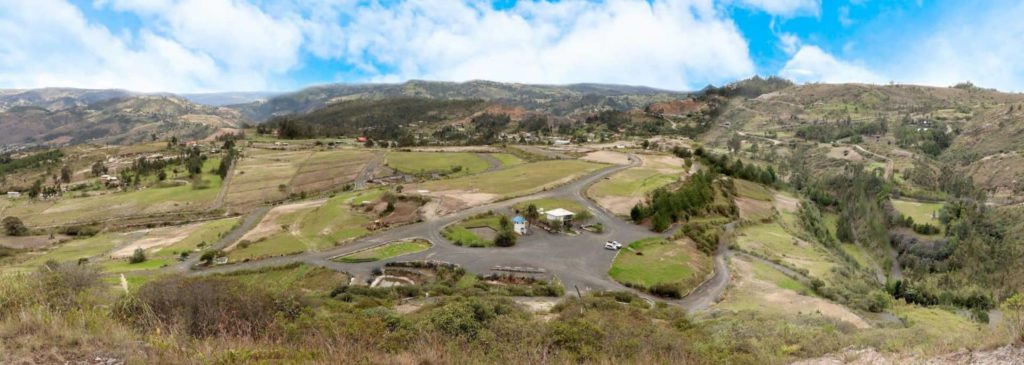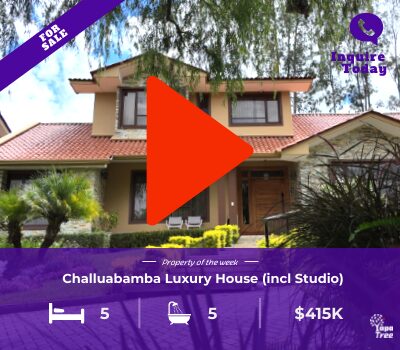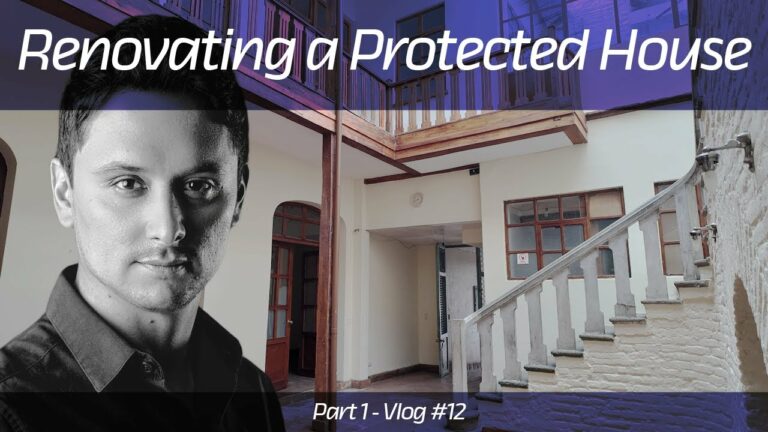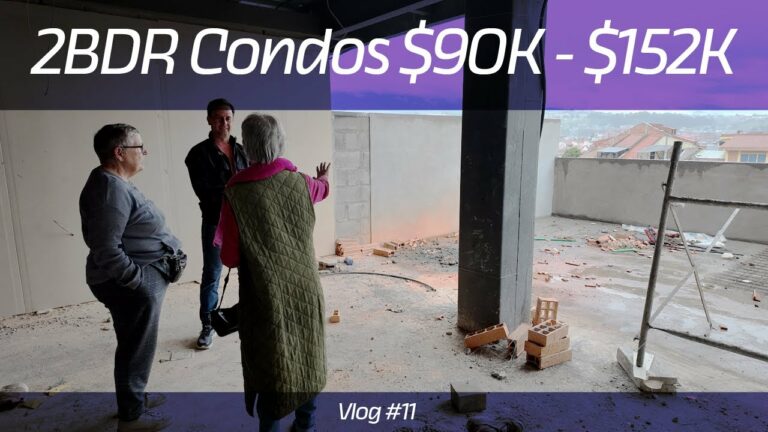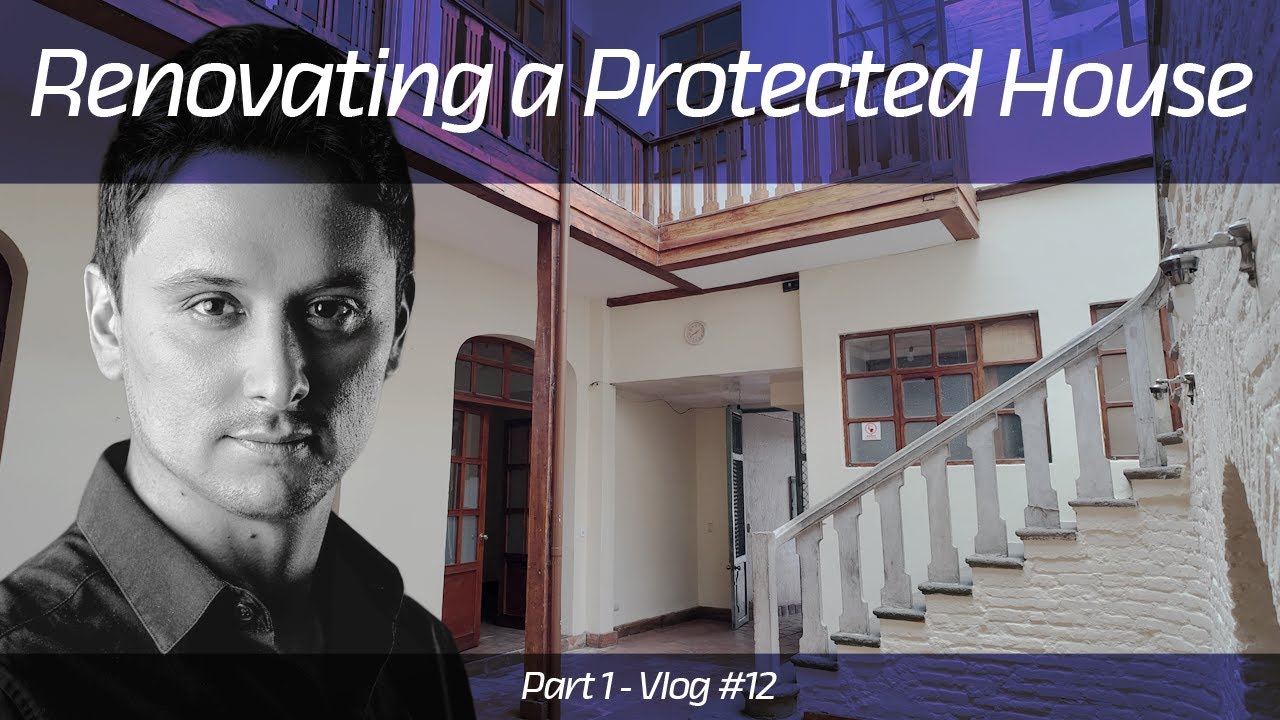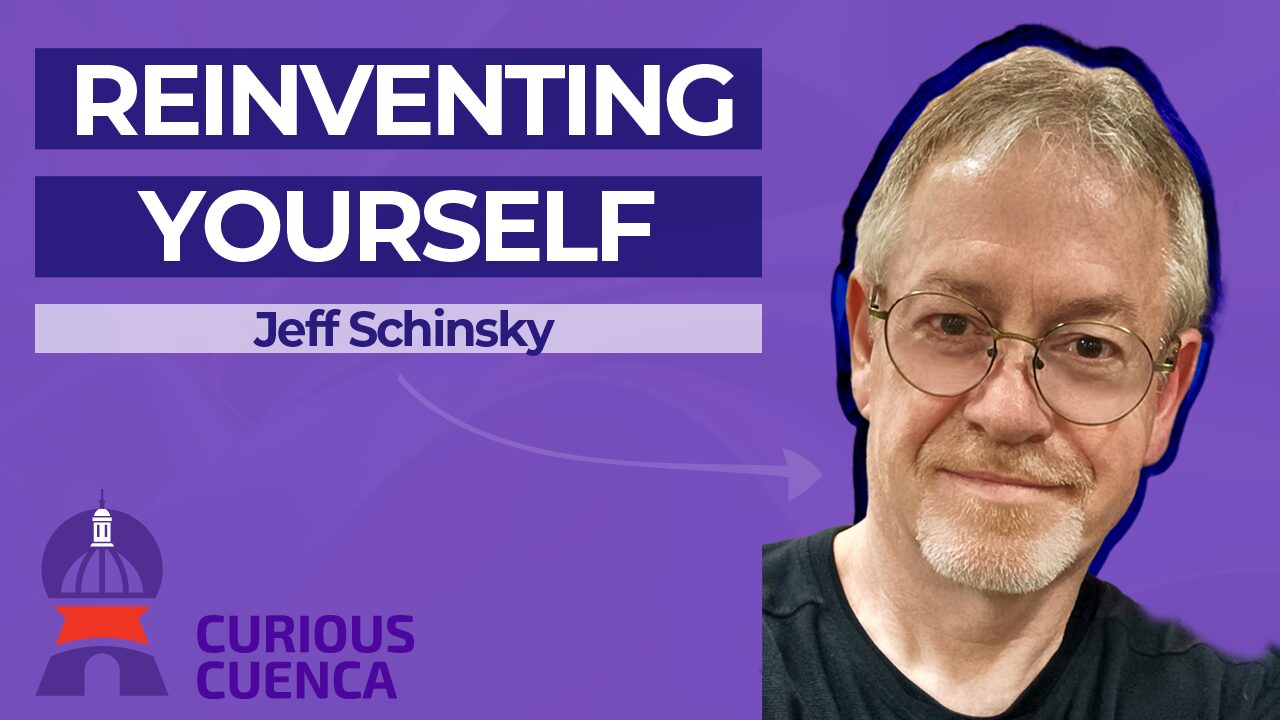It’s easy for expats to be lured to Cuenca by the affordability of property and land prices. Of course, the price varies depending on various factors, including location, slope & quality. Aside from price, there’s a lot of other factors to consider before taking the plunge.
We are in the early stages of looking for some land where we can have a small hobby farm and space for our kids to roam, explore and hurt themselves (just a little bit).
We’ve consulted numerous property experts and are using a real property development close to Cuenca as a case study to illustrate key points. Our hope is that after reading this guide, you’ll be able to safely and confidently purchase land in Cuenca.
Let’s do this!
Mirador de Challuabamba – Our Case Study
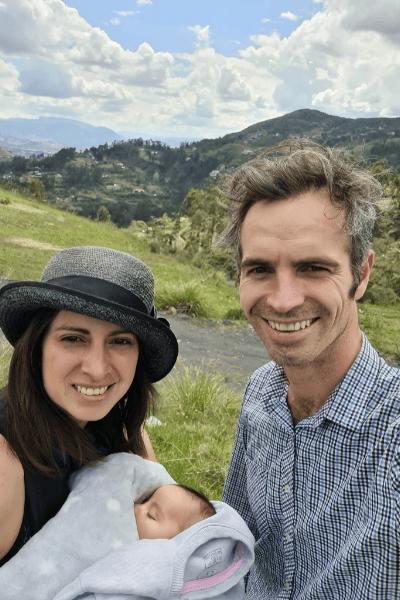
We’ve chosen a local property development project to use as a case study. Why have we chosen Mirador de Challuabamba?
- Because it’s a real purchasing opportunity that we can use to better explain the process
- It’s a large development that is close to Cuenca and close to our home in Challuabamba, meaning it’s easy for us to access & take pictures etc.
- You deal directly with the owners, which is a common scenario in Ecuador
- We think this particular parcel of land has potential and may be of interest to our readers as a buying opportunity
The risks of buying land
Given the emotions and excitement that often surround land purchases, it can be easy to overlook or even purposefully diminish the potential downsides of purchasing land.
So, we like to focus on the risks first, just to make sure these are always front of mind.
1. Reselling
Trying to make a quick buck by flipping land here? Best of luck to you. Whilst not impossible, this is a very different property market than you’re used to and you are an outsider. Unless you really know the local property market, our suggestion is to skip any thoughts of a quick flip.
It’s not uncommon for a property to take years to sell. There’s no local MLS and regulation is weak. Rather than sell at a loss, locals will generally prefer just to hold on to the land.
Culturally, many Ecuadorians prefer to have their life savings in property rather than other investments such as banks or stocks. And, land taxes in Ecuador are ridiculously low. This also means that holding costs are also low with little incentive to sell unless their price expectations are met.
2. Land measurements
Obviously, you want to receive the same sized parcel of land that you’ve purchased. Sometimes this is easier said than done, especially if the boundaries haven’t been marked up over the past 10 years or so where GPS technology has significantly improved land boundary accuracy.
But, having the boundaries property referenced by a professional costs money, so there is the temptation to try and sell land without. If you agree to this path, you’re opening yourself up to future border disputes with your neighbors.
These disputes can turn ugly, quickly. But, even if they don’t, you may find yourself being taken advantage of by neighbors that encroach on your land just because they know you have no proper defense as you can’t prove the boundary. In this instance, one option would be to have the geo-coordinates survey completed by a professional (at your cost).
What developers say
We asked Mirador Challuabamba how they ensure the property sold is the same the buyer receives:
“Currently, when buying a plot of land, a “georeferenciado” (geo-referenced) plan is enclosed, where the geographic coordinates of each vertex of the land have been noted. This makes it difficult for any party to dispute boundaries in the future.
These plans are prepared by the developer and approved by the municipality, so it is rare that they contain errors. Even so, you could, with this plan and a little geometry, calculate the area and compare it with the offered area.
All this data (including the approved plans) are provided with the “Escritura de compra-venta notarized”. At the time of signing, the notary will read in front of all attendees the dimensions of the land, indicating the area in square meters as well as the length of each segment. This allows both the buyer and seller to validate these details. These georeferenced plans are part of the public deed and form part of the contract of sale.
In the case of Mirador de Challuabamba, every lot is also delimited with cement post boundaries.
You should keep in mind, especially in rural areas, that you may end up conceding one or two meters of land to the municipality at some point if they decide to build sidewalks and access roads. This is particularly true in rural or any area that doesn’t yet have these built.
Wrong (restrictive) title type
One of the easiest ways for expats to get caught up in a contractual mess is not properly understanding the full ramifications attached to each title type, and how this affects their individual property.
Remember, there is no title insurance in Ecuador, so the onus is on you to complete all the required due diligence.
The three most common title types you’ll likely come across are:
- Escrituras Publicas: This is generally considered the ‘safest’ title as you have the most rights.
- Acciones y Derechos: A little riskier because there are potential caveats attached to what you can do with the property such as sub-dividing. Be prepared to do a lot more due diligence on this title type.
- Communa: As a foreigner, we suggest staying away from this type of land unless you really know what you’re doing. And, if you’re reading this guide, chances are you’re still coming to terms with Ecuadorian property, so let’s just leave this option off the table for now.
Scams and overpaying
Buying property anywhere has risks. But, when you don’t speak the language, aren’t versed in the purchasing process, and don’t have the same cultural background, you are more susceptible to overpaying or even scams.
Some expats do arrive with the perception that every local vendor is out to ‘gringo gouge’ them. In my experience, this is far from the case. But, I’d also be lying if I said I hadn’t experienced some ‘opportunistic price enhancement’ when it became clear I wasn’t from around here.
If it makes you feel any better, Michelle is from Quito, and she also experiences this from time to time. But, negotiating is part of the culture, and once you accept this, you’ll likely feel less like a victim and more like just another citizen trying to get by in this crazy world.
Your best weapon against scams or overpaying is to complete due diligence on:
- The title: Your lawyer can complete this for you and raise any red flags
- Geomechanics: Is the land stable to build on? An engineer should be consulted if in doubt.
- Basic services: Is electricity and water currently available? If not, how will these be provided in the future and who is paying for it?
- Access: What access is currently available and/or planned for the future? The more remote the property, the more important this becomes.

The property buying purchase
Whilst the purchase process isn’t overly complicated (especially compared to registering a car…), you do need to ensure you’ve covered yourself with the proper use of contracts throughout the process. This will inevitably involve visit(s) to a notary to ensure everything is legal.
Sidenote – notaries are very important in Ecuador. You’ll use them for many legal processes. Think of them as lawyers with additional training. It used to be a very lucrative profession as notaries could set their own prices. The government has since regulated the prices, so you shouldn’t find too much discrepancy between various offices – although there’s still enough gray area that prices may not be identical.
What property developers say
The legal process is the same when purchasing land with or without a house. The steps are:
- Deposit (earnest money)
- Contract: promise to purchase
- Pay Installments
- Contract: purchase
- Delivery
1. Deposit
A small amount that commits the parties verbally. Once the deposit or earnest money is received, the developer will not sell the land to anyone else. An amount of $500 is common. This is delivered to the developer via bank transfer, cash, or check. Sometimes a receipt is issued – with the bank transaction records being used as proof of payment (if needed).
2. Promise to Purchase-Sell (Promesa de Compra-Venta)
This contract involves the developer promising a date when the house/apartment/land will be ready for delivery and when it is ready, it will be sold to the buyer.
There is also normally a substantial down payment made (8% is common but does vary) along with monthly installments until 30% of the total has been paid to the developer. Be sure to note any penalties for non-compliance which can be 5% of the total value.
This Promesa de Compra-Venta is executed at a notary where the client usually bears the cost. The clauses of the Promesa de Compra-Venta usually specify how the down payment is made, including the payment method (check, certified check, or cashier’s check).
We suggest not using cash so you don’t have to worry about security when carrying large sums of money around. A cheque will also provide evidence of the transaction, which can be more difficult if paying with cash.
Note, if you have the cash and you’re ready to close the sale right now, you can skip the Promesa and just go straight to the Contrato de Compra Venta (below).
3. Installments
Now you need to start making the installment payments you agreed to in the Promesa de Compra-Venta. These are generally paid monthly, but you may be able to renegotiate once or twice without penalty.
4. Contract of Purchase & Sale (Contrato de Compra Venta)
Only once the property is ready for transfer, the parties can sign the Contrato de Compra Venta. This will also specify the payment method. This is also executed at the Notary. If you don’t speak Spanish, you are legally obligated to have an interpreter present (for your protection).
Notary fees
The approximate notary costs, depending on the sale price generally range from $250 to $450.
Can I get a mortgage?
Foreigners find it very difficult to obtain a mortgage as they generally don’t have sufficient history (credit & employment etc). Even if you could obtain a mortgage, the interest rates are very high at around 10%, making a cash purchase much more attractive.
But, the high-interest rates work the other way too. 9-10% interest is available for Certificates of Deposits (CDs) at cooperativas, with banks offering around half this.
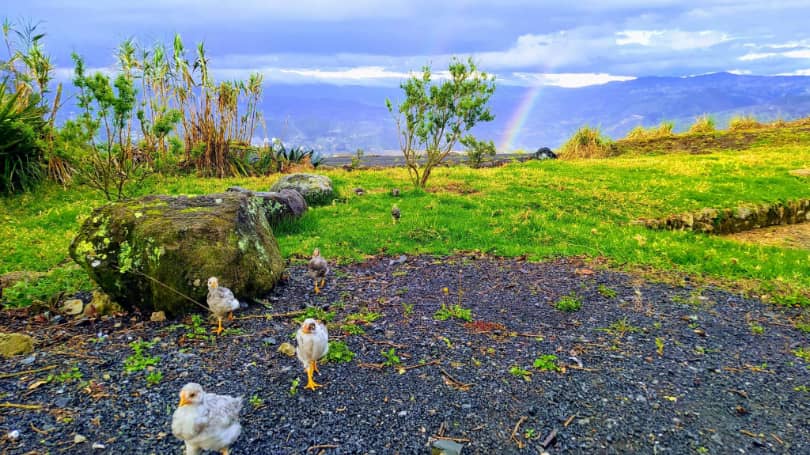
Zoning & Timing Considerations
It’s also helpful to understand distinctions in the following:
Urban vs Rural Zoning
This is going to affect your building permits and taxes. As a general rule, rural areas are easier and cheaper than urban. Property in rural areas is often acquired for family holidays homes, hobby farms, or retirement homes.
Immediate vs future delivery
When is the property available for delivery? The longer you need to wait to take delivery, the more risk you’re taking on and this increased risk should be reflected in the price.
Pay particular attention to the plans for providing access to the property as some subdivisions can take years to build vehicle access. The other common time blowout can be during the process of legalizing the plans so they can be sold.
Private vs independent development
Some expats seek private gated communities for various reasons such as increased security & relative freedom it affords for kids to run around without constant supervision. But, others (like our family) prefer to have an independent house where we have full autonomy over our property and don’t need to adhere to any community rules we don’t agree with.
It really comes down to personal preference and how much flexibility you need.
What Mirador Challuabamba offers
El Mirador de Challuabamba is currently classified as:
Zona Rural
It’s very close to what is known as the “Zona de Expansión Urbana”. This area belongs to the rural parish of Nulti in the canton of Cuenca. In addition to entrances to Cuenca, there are also access roads leading to Gualaceo, Paute & towards the jungle.
Ready for Delivery
Property is available to be purchased and built upon right away
Independent
Whilst each owner has full authority over their property, the lots have been designed to have harmony between them.
Land size & price
The lots offered are large, which means the price per square meter is generally cheaper than other land available in the area.
Buying from owner vs agent
Like in many countries, buyers can choose to use a real estate agent to help sell land on their behalf. But, there are some key differences to how agents work compared to other markets:
1) No exclusivity
It’s pretty rare for owners to sign exclusively with one agent. This puts agents in a pretty tough position as they can do a lot of work, only to have another agent swoop in and take the sale from them. For this reason, competition amongst agents can be fierce.
2) Low commissions
The standard commission paid to agents by the seller is 3%. This is relatively low compared to other Latin American countries (7.5% in Brazil, 5% in Argentina).
The combination of no exclusivity and low commissions puts the seller in a great position. They can have many agents working to sell the property for relatively minor commissions.
So, theoretically, if you buy direct from the owner they will save this 3% commission and you could definitely use this to your advantage during price negotiations.
3) No buyers agents
Are you starting to see a common theme? The property market in Ecuador is still very basic. One ramification is that buyers agents are not yet common.
So like real estate agents anywhere, they have a vested interest to sell the property for the highest price. They certainly have no incentive to negotiate on your behalf to get the lowest price.
What Property Developers say
Mirador Challuabamba does not have a preference. We work with agents and direct with buyers. Good agents can be very helpful in facilitating the sales process which can ultimately benefit both the buyer and the seller.
But, we don’t just work with any agent. We only work with agents we’re confident we can trust, that have the right attitude and are punctual.
Taxes
When talking about property prices, it’s important to understand there can be significant differences between the actual sale price and the price used for tax purposes.
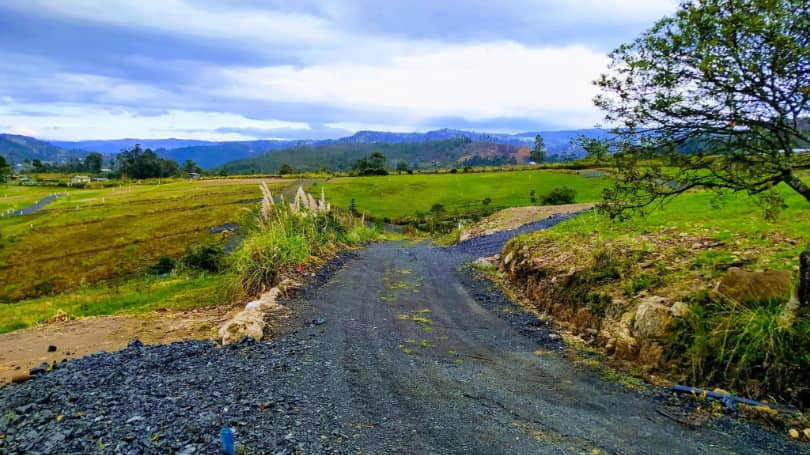
Assessed value for tax purposes
This can be much less than the actual sales price. How much? One-third less is not uncommon. This is the reported value that the owner pays tax on so there is an incentive to keep this as low as possible.
The problem with this approach is that over time, the gap between the two values can continue to widen, potentially leaving the new owner with higher tax obligations if they choose to declare the actual sale value.
What Mirador Challuabamba says:
Let’s use some real figures from Mirador Challuabamba to illustrate the different taxes payable by the buyer.
Municipal tax alcabala
This minor tax of $6.00 applies when buying property in this rural area.
Annual property tax
Annual Urban Property Tax to the GAD (Decentralized Autonomous Government, commonly known as the Municipality), which ranges between $10 and $100 in this rural area. They provide discounts for early payment too:
- 10% discount if paid in January
- 9% discount if paid in February
- And so on
Patrimonial Declaration to the SRI
This applies to individuals that have more than $1M in Ecuador or $2M as a couple. Theoretically, it is only a declaration that does not generate taxes, but “occasional” taxes could be decreed on it. This has happened in two different years in Ecuador.
Municipal taxes for improvements
These taxes could be applied once the area has been incorporated as urban for several years. But, only if the municipality makes improvements, such as the construction of parks, can they offset some of these costs to the owners of the properties that have received a benefit.
Our suggestions for the declaration amount
We are not accountants and suggest buyers talk through their potential property tax implications with a qualified tax professional.
But, we believe it is always better to pay fair taxes, without overpaying or evading them. The main factor that determines the value of the taxes is the appraisal of the land, the higher the appraisal, the higher the taxes.
We recommend declaring the total value of the land.
Negotiating
This is quite a topic that can be difficult for foreigners that come from a fixed-price background to come to terms with.
How prevalent is negotiating amongst Cuencanos? Enough for us to name our website after it. The ‘yapa’ in YapaTree means something you get for free during a sale or negotiation. For example, at the local fruit market don’t be afraid to ask for a small ‘yapa’ at the end of the transaction. They might give you an apple or a banana etc. I really like this part of the culture so long as it’s done with the right attitude and humor.
Combine this culture of negotiating with a product that rarely has a fixed price (ie land), and you’ll start to understand how important it is to up your negotiating game.
Don’t tell anyone, but my secret is getting Michelle to make the initial price inquiries simply because she is much better at negotiating with locals than I am. Being Ecuadorian certainly helps too, but Cuencanos still largely see her as an outsider as her accent is clearly Quiteño.
It can be a good idea to use a local facilitator to make the initial (or ongoing) price inquiries if you’re worried about buyers setting inflated initial prices.
Establishing fair market value
This can be the most difficult and frustrating piece of the property buying puzzle. Without an MSL or ‘comps’ to rely on, your only real option is to do the data compiling yourself.
Find declared property values online
The closest you’ll find in Cuenca to a publicly available dataset of land prices is the declared values provided by owners. You can access these if you have the cedula number of the property owner via the GAD Municipal for each canton. Here’s the link for Cuenca.
But, as we’ve previously discussed, these declared values can be MUCH lower than any actual sale price, so be careful about reading too much into these declared land prices.
Sold prices for nearby land
This isn’t going to be a super-efficient process. Be prepared to hit the streets to ask neighbors how much land has been recently selling for, calling numbers on any makeshift for sale signs you come across.
Online marketplaces can also provide a reasonable starting point. Facebook Marketplace is a popular place to look as are platforms like OLX. For OLX, it’s more accurate to look for the advertisements that have ‘closed’ because these are more likely to be closer to the final price and not inflated to aid the buyers’ initial negotiation position.
How much should I offer?
Great question. If you’ve done enough research on the price that neighboring properties have recently sold for, you should now have a very good estimate of what the general cost per square meter is in the area.
Don’t be afraid to offer slightly under this. Even if a property is reasonably priced, owners still expect to be bargained down a little and you certainly won’t be offending anybody. They just may not call you back with a counter-offer if you’ve been too aggressive.
If you’re buying via a new development, then the earlier properties sold usually have the best deals because the developer can point to these sold properties to help sell the remaining properties. Our herd instincts kick in and we want to be buy properties that are popular with other buyers. Later, when most of the lots have been sold already, this can lead to FOMO (Fear Of Missing Out) where the opposite occurs; the owners know they can easily sell the land so they don’t need to offer discounts.
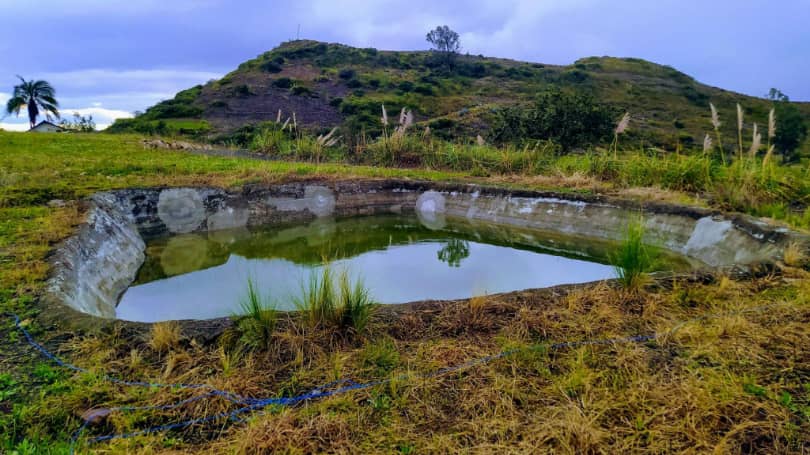
Negotiating with Mirador Chulluabamba
We asked Mirador Challuabamba about this negotiating culture and their recommendations for negotiating with landowners or property developers.
Cuenca’s negotiation culture
Negotiation is ingrained in Cuenca, it is part of the charm. In the case of land, you can’t give extra square meters as a discount, so the only thing left is to give a discount on the price. There are very few, if any, occasions where land for sale has a fixed price.
How much do developers discount?
I think that on land that has a reasonable list price, it is possible to get a discount between 2% and 6%. This will generally depend on:
- How many lots have been sold – you can get bigger discounts at the start
- Payment method
- Speed of purchase
- Affinity between the seller and buyer
Be careful with lots that have an inflated list price. In these cases, it will be easy to see a discount of 15% or more, but you have to understand that in reality, this isn’t a discount, but an inflated initial price.
How have you determined your land prices?
The prices of Mirador de Challuabamba are definitely below-market prices, i.e. below the prices that have actually been sold in the area.
One of the reasons we’ve had to set prices so low is because of the impact COVID has had on the market. But, the main reason we’ve set low prices is we want to sell the property quickly. Our goal is to sell 80 lots in the upcoming months.
We do not want a long, drawn-out sales process so setting low prices will help us achieve quick sales.
What are your list prices?
We’ve provided list prices on our website.
Why do you consider these prices ‘fair’?
Mirador de Challuabamba has a cost per square meter that is less than what nearby properties have recently sold for.
Our land also has features that some of these more expensive properties don’t have. We believe this will allow for substantial capital gains in years to come. Good capital gains can be realized if the land has unique characteristics, or is a popular neighborhood that is close to future works such as highways or other main roads.
Some of the unique & favorable characteristics of the land we’re selling at Mirador de Challuabamba:
- Unique terrain of each lot
- Panoramic views of Cuenca and Azogues
- Road system currently in place
- Several rainwater reservoirs
- Proximity to existing paved roads
- Harmony with nature, including a large hill
- Numerous municipal projects planned
- Large minimum lot size (1,000 m2) designed to attract upper middle class families
Who is your ideal buyer?
Our ideal buyer is someone who is willing to take the time to get to know the entire project. Including the uniqueness of the land, surrounding landscape, and nature as well as the 4km of roads that run through the property.
This is a project in harmony with nature, it isn’t for someone that needs to live in the middle of a city
We don’t want a rushed buyer that simply looks at the very competitive price per square meter and doesn’t care about the other factors.
We encourage you to visit El Mirador de Challuabamba with the mindset that you’re willing to take at least 1 hour to visit. This will allow enough time to walk around the property with the owners whilst answering any questions you may have.
How property development works in Ecuador
I thought it would be valuable to turn the tables, putting yourself in the shoes of the property developer. We asked Mirador de Challuabamba what they see as the main risks to property development projects in general and how they’ve tackled them with their project.
Main risks to land development projects:
- Project financing: executing real estate projects requires significant financial resources & obtaining finance is always difficult in Ecuador
- Slow speed of government to provide approvals
- Time overruns due to construction problems and political interests
- Complications when the land is in indigenous communities or social organizations
- Lack of access roads, and lack of public works in general
- High land costs
- Low quality (ie unstable) land
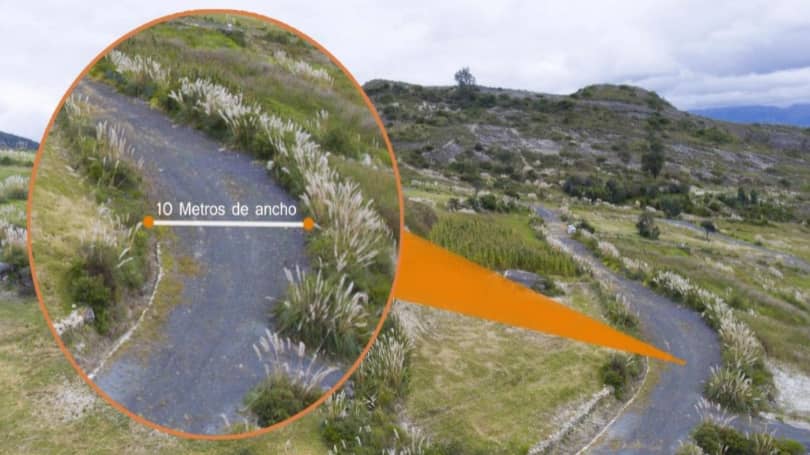
What are the main risks identified by Mirador Challuabamba’s development?
Mirador Challuabamba is ready for immediate delivery, so I must say that at this point the main risks have been overcome. It was not easy, but we did it. More on these specific risks in the next section.
We’d say our current concerns are:
- The land could sell slower than expected (or too fast, we don’t know!) We hope to sell the whole project in the next 24 months. Faster is better as it improves the return on investment. We are therefore preparing to launch the project in January 2022 with great fanfare, website, flyers, and signage.
- Covid-19 has caused an unprecedented economic recession, which has forced us to lower sales prices to be competitive in the market.
Our advice to future land owners
We also want to note that land management by future owners will have its normal challenges:
- Permits: Building a house will require obtaining building permits much like it does in most places in the world. But in Ecuador, the process may not be as fluid depending on circumstantial factors and the good will of public officials etc.
- Infrastructure works (water and electricity) must be arranged after the purchase. In the area there is potable water supply from the city of Cuenca (Etapa). The neighbors already have potable water and electric power, so this should not be difficult. There is also high-speed Internet service throughout the area.
Obtaining approvals with the necessary public officials is generally easier when there are more people involved. So, we hope that a significant percentage of lots are sold within the same time period to make it easier for these owners to arrange supply of electricity and drinking water.
To clarify – these services can always be accessed as the right to basic services is guaranteed in the constitution of Ecuador. It is simply easier to do it among several people than a single owner.
Be careful with deposits
Except for the ‘earnest money’, we only suggest handing over money when you’re signing a notarized contract such as the Compra Venta.
Other ‘hidden’ risks
There is no such thing as the perfect property. If the owner presents a property that seems too good to be true, then it most probably is. Some of the issues that can be difficult to see on the surface:
- Unstable land or land located near geological faults
- Flooding risks for areas close to rivers.
- Land belonging to indigenous communities have significant limitations that you should verify with a lawyer
The bottom line is if you can’t personally verify all items in your due diligence process, then you should walk away from the deal.
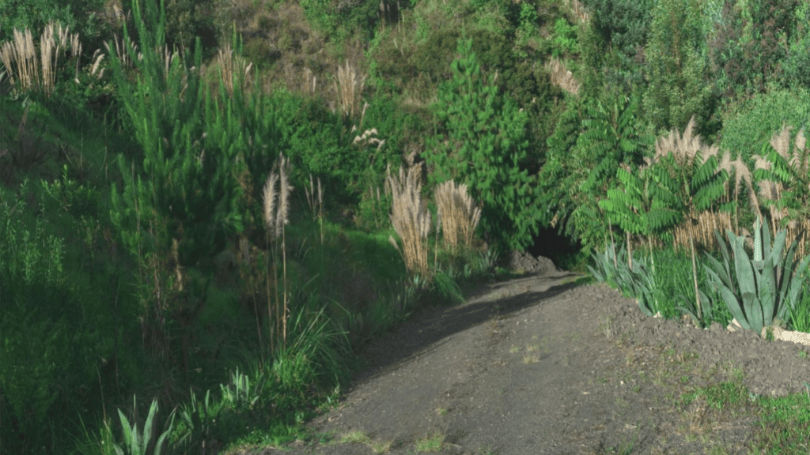
Do any of these risks exist at Mirador de Challuabamba?
None of these ‘hidden risks’ exist at Mirador de Challuabamba. But, of course, we encourage you to make your own assessments.
Stable and dry
The land of Mirador de Challuabamba is stable and there are no geological faults on or nearby the property. Geologically, it is formed by compacted sandstone so the foundation is solid and safe.
There are no rivers, the climate is stable, and receives only 23% of the rain that Cuenca does – according to existing studies in the area.
Development zone
El Mirador de Challuabamba is in a development zone, surrounded by several properties owned by people who have moved from the city of Cuenca to enjoy the countryside without leaving the urban area.
The land is ready for immediate delivery and use.
Close to Cuenca – 8 minutes from Challuabamba (& Supermaxi)
Challuabamba is a booming urban area of Cuenca. You can find all modern amenities such as supermarkets, gas stations, hardware shops, general stores, delis, study centers, gyms, restaurants, pharmacies, etc.
Ecuador’s most popular supermarket chain, Supermaxi, opened here in 2021. There’s a lot of development happening in this area which is normally a good sign for future capital gains.
El Mirador de Challuabamba is 8 minutes from the main autopista. This allows for easy access to Cuenca. There are several access roads as shown in the promotional maps – one of these is paved from the highway to 200m before the property.
Bringing it all together – Mirador Challuabamba as a buying opportunity
So far, we’ve mainly focused on how to avoid potential pitfalls when buying property near Cuenca. Now, let’s switch gears and focus on some of the features of Mirador de Challuabamba.
360 Views of Cuenca & Azogues
Mirador in Spanish means viewpoint. This will make perfect sense once you visit and see the expansive views over Cuenca (one side) and Azogues (other side). There are lots available on both sides you get to choose your viewpoint.
Either side also provides views of the Andean landscape, including native flora and fauna.
Tranquility
This land is definitely better suited to those that appreciate the ability to unwind in peace and comfort whilst enjoying the views. It’s a quiet area set amongst the countryside, but with the amenities of Challuabamba and Cuenca close by.
Challuabamba down the road
At the bottom of the mountain sits Challuabamba only 8 minutes away by car. The drive from Challuabamba to Mirador de Challuabamba is very nice too.
Personality
This land has belonged to the same family for generations. It’s mainly been used as their private sanctuary to escape from the outside world. This history can be seen when you visit in the various paths, access roads, plants & water reservoirs.
But, what impressed us the most is the attention to detail and how they’ve incorporated nature into the property. These are really impressive foundations for the development to build upon and I’m sure they will.
If you have the chance to tour the property with the family, they will fill you in on all of the history, effort, and stories that make this land unique. It’s very clearly a well-loved property that the family has thoroughly enjoyed for many years, but it’s now time for them to share with others.
Large lots
Whilst the price per square meter is very competitive, the large lot sizes are designed to attract middle and upper-class owners. This should translate into a quality, respectful neighborhood.
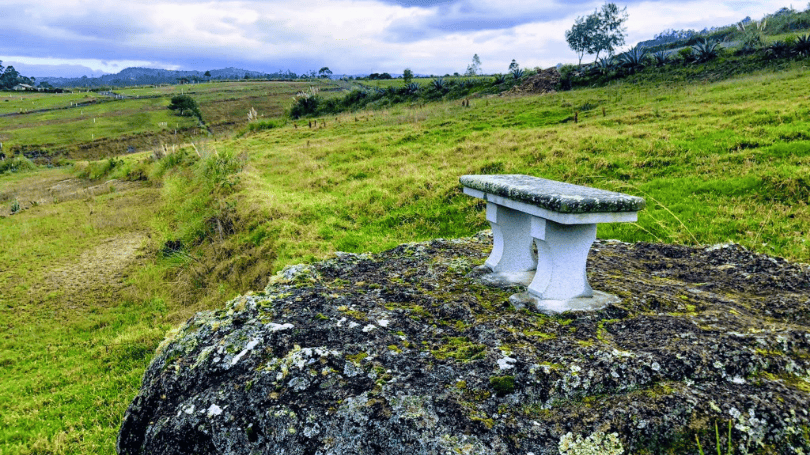
How to contact Mirador de Challuabamba
Intersted in talking to Mirador de Challuabamba? You can complete the form below and they’ll receive your inquiry immediately. They speak English and are very relatable. Chances are you’ll get on very well with them (we have).
They offer payments in installments (via a Promiso de Contra Venta) and are willing to negotiate – particularly if more than one lot is under consideration.
You can also visit the Mirador del Challuabamba website for more photos, lot prices & sizes.
Wrapping up
This turned into quite the guide. We hope it’s given you the knowledge and confidence to go out there and start your journey into buying land near Cuenca.
There’s obviously still a lot more to cover, so you’re always welcome to reach out to us with any questions on the buying process and we’ll do our best to connect you with qualified professionals if we can’t answer the question ourselves.




